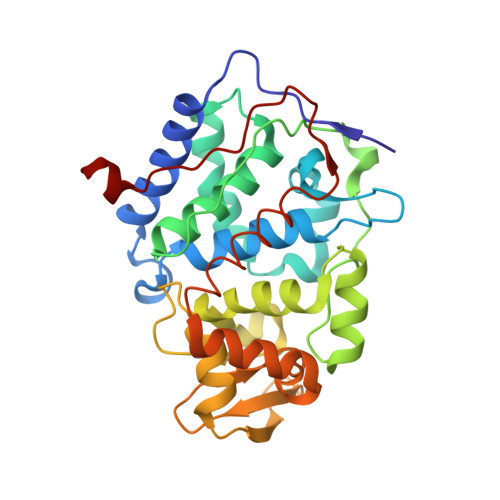Kinetic and crystallographic studies of a redesigned manganese-binding site in cytochrome c peroxidase
Pfister, T.D., Mirarefi, A.Y., Gengenbach, A.J., Zhao, X., Danstrom, C., Conatser, N., Gao, Y.-G., Robinson, H., Zukoski, C.F., Wang, A.H.-J., Lu, Y.(2007) J Biol Inorg Chem 12: 126-137
- PubMed: 17021923
- DOI: https://doi.org/10.1007/s00775-006-0171-0
- Primary Citation of Related Structures:
2IA8, 2ICV - PubMed Abstract:
Manganese peroxidase (MnP) from the white rot fungus Phanerochaete chrysosporium contains a manganese-binding site that plays a critical role in its function. Previously, a Mn(II)-binding site was designed into cytochrome c peroxidase (CcP) based on sequence homology (Yeung et al. in Chem. Biol. 4:215-222, 1997; Gengenbach et al. in Biochemistry 38:11425-11432, 1999). Here, we report a redesign of this site based on X-ray structural comparison of MnP and CcP. The variant, CcP(D37E, V45E, H181E), displays 2.5-fold higher catalytic efficiency (k (cat)/K (M)) than the variant in the original design, mostly due to a stronger K (M) of 1.9 mM (vs. 4.1 mM). High-resolution X-ray crystal structures of a metal-free form and a form with Co(II) at the designed Mn(II) site were also obtained. The metal ion in the engineered metal-binding site overlays well with Mn(II) bound in MnP, suggesting that this variant is the closest structural model of the Mn(II)-binding site in MnP for which a crystal structure exists. A major difference arises in the distances of the ligands to the metal; the metal-ligand interactions in the CcP variant are much weaker than the corresponding interactions in MnP, probably owing to partial occupancy of metal ion at the designed site, difference in the identity of metal ions (Co(II) rather than Mn(II)) and other interactions in the second coordination sphere. These results indicate that the metal ion, the ligands, and the environment around the metal-binding site play important roles in tuning the structure and function of metalloenzymes.
- Department of Biochemistry, University of Illinois at Urbana-Champaign, 600 S. Mathews Ave, Urbana, IL 61801, USA.
Organizational Affiliation:


















